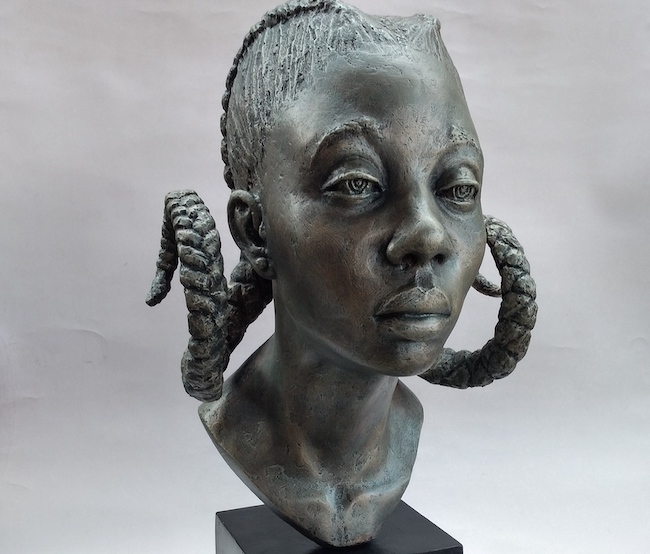Nell’arte contemporanea si assiste spesso a una totale innovazione stilistica, a un superamento di tutto ciò che aveva contraddistinto i linguaggi precedenti per elaborare e generare qualcosa di distante e distaccato dalle regole e dagli schemi del passato; in questo percorso di rigenerazione alcuni artisti tendono quasi a dimenticare le origini artistiche e narrative, quasi come se il punto di vista debba necessariamente protendersi verso la contemplazione e la comprensione del presente. Ve ne sono però altri che non possono fare a meno di ricordare le tradizioni della loro terra per mescolarle alle tecniche attuali dando vita così a uno stile riconoscibile, originale e affascinante.
A partire dai primi anni del Novecento, il continente africano cominciò a esercitare una forte attrattiva sugli artisti europei che furono incentivati dalla inedita facilità di spostamenti grazie alla creazione di navi più veloci rispetto al secolo precedente, a spostarsi per andare a studiare da vicino quelle maschere tribali, quelle immagini tradizionali e stilizzate che divennero la base di elaborazione per sculture e dipinti di alcuni tra i maggiori esponenti dell’arte di quel periodo; quel nuovo interesse passò alla storia con il nome di Primitivismo. Pablo Picasso prese spunto dalle immagini degli intagliatori e scultori locali per disegnare i volti delle sue opere sfaccettate, scomposte e raffiguranti diversi punti di osservazione annullando la profondità e la prospettiva, così come Amedeo Modigliani si ispirò proprio alle tradizionali sculture lignee africane per elaborare graficamente le sue donne dai lunghi colli, sia nelle opere pittoriche che nelle poche scultoree; e ancora Henri Matisse, esponente dei Fauves e successivamente aderente all’Espressionismo, comprese la forza espressiva della semplicità delle maschere tribali da cui trasse ispirazione per i suoi coinvolgenti dipinti. Superato il periodo del colonialismo e intrapreso il percorso di compenetrazione tra le differenti culture, quella africana e quella europea, cominciarono a delinearsi nel continente al di sotto del Mar Mediterraneo diverse scuole d’arte attraverso le quali gli allievi potevano approfondire le tradizioni del passato e contemporaneamente studiare le tecniche classiche elaborate dai grandi maestri internazionali e di cui poterono approfondire e personalizzare la cifra stilistica lasciando emergere il proprio talento in maniera libera, meno condizionata dalle accademie europee e decisamente più legata alle tradizioni dei loro paesi di origine. Fu proprio tra gli anni Cinquanta e gli anni Ottanta che il mondo artistico mondiale cominciò a guardare con attenzione alla nuova generazione di artisti africani organizzando mostre collettive in tutto il mondo per permettere alla loro produzione creativa di essere conosciuta a livello internazionale. Tra i nomi di spicco di questa nuova generazione di artisti non è possibile non citare l’egiziano Fati Hassan, primo artista africano a partecipare a una Biennale di Venezia, quella del 1988, i cui dipinti e installazioni mescolano un forte simbolismo a lettere dell’alfabeto arabo che divengono così opere d’arte, e l’Informale Materico del ghanese El Anatsui che usa argilla, legno e stoffe tradizionali della sua terra per creare grandi arazzi in cui il fascino delle solenni cerimonie Nyekor si unisce a quello dei tessuti Kente. L’artista nigeriano Luke Osaro si inserisce all’interno di questo panorama creativo contemporaneo attraverso la scultura nella quale mantiene un forte legame con la sua terra di cui rappresenta regine, donne comuni, anziani saggi e orgoglio di appartenenza al suo popolo, con una forte capacità simbolica in grado di infondere ai suoi personaggi un’aura di referenziale rispetto, come se il concedersi all’osservazione costituisse un dono di fiducia all’artista che li stava immortalando, certi di essere interpretati nel modo giusto, nella loro spontanea natura.
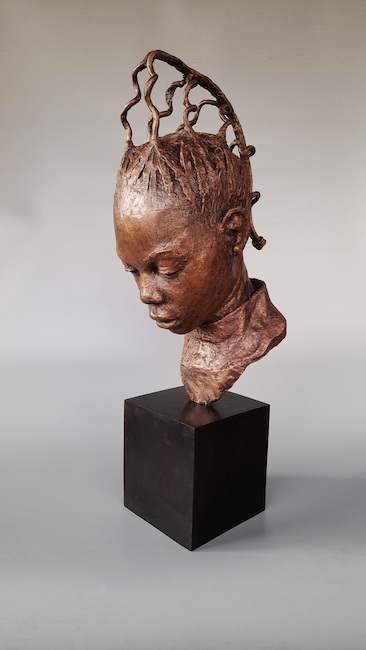
Laureatosi in Belle Arti presso la prestigiosa Università di Obafemi Awolowo, nell’Ile-Ife dello stato di Osun in Nigeria, Osaro ha avuto modo di sperimentare e fondere la sua ispirazione creativa, le tradizioni del suo paese e l’approccio esecutivo classico per dare vita a opere d’arte affascinanti, silenziose ma fortemente espressive in cui la magia del continente a cui l’artista appartiene emerge e avvolge l’osservatore per la capacità di parlare in maniera diretta, semplice e al tempo stesso volta a svelare tutto ciò che appartiene alla sua gente, l’orgoglio, la solennità, la regalità che trapelano dalle pose, dagli sguardi, dalle acconciature che l’artista racconta.
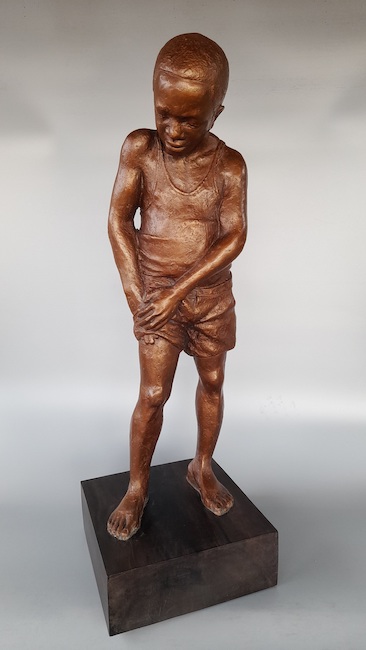
I materiali utilizzati sono il bronzo e pietra incollata in virtù dei quali Osaro dà sfogo alla sua maestria nel plasmare per mettere in evidenza espressioni, dettagli, particolari imprescindibili dai soggetti che decide di raccontare e di descrivere nella loro complessità.
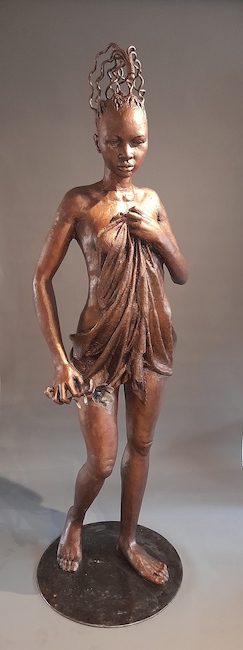
Nella scultura Scent of Eden l’artista raffigura la giovane donna di una tribù coperta da un velo di stoffa essenziale per non mostrarsi completamente agli sguardi esterni ma al tempo stesso desiderosa di essere notata, quasi in attesa del verificarsi di un evento, di un incontro per il quale si è adornata come da tradizione; il volto tradisce la trepidazione mentre l’acconciatura svela l’aspettativa della ragazza, un essersi accuratamente preparata per ricevere un innamorato o una circostanza importante verso la quale tende. Il bronzo si associa in maniera armonica ai tratti della donna, come se fosse il materiale più adeguato a ribadire l’appartenenza a una razza che finalmente si sta affermando in maniera prioritaria nel resto del mondo, dopo secoli di silenzio e di sottomissione, anche attraverso l’arte, svelando senza più aver bisogno di gridare, gli usi e i costumi, la serenità espressiva del vivere in maniera ancora molto legata alla natura, alla semplicità di un ritmo più lento di quello delle civiltà occidentali.
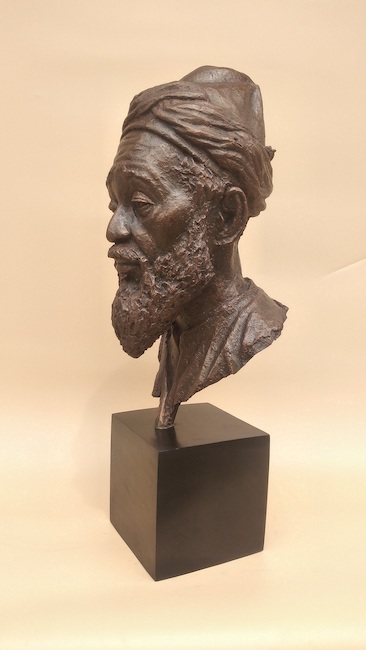
L’opera Hakimi, nome nigeriano che indica un capo tribù, racconta del grande rispetto che il popolo africano ha nei confronti degli anziani, in realtà veri e propri saggi perché detentori delle tradizioni che devono essere tramandate alle nuove generazioni; il volto dell’uomo è solenne, incute rispetto proprio per lo sguardo profondo e meditativo ma al tempo stesso desideroso di trasmettere le sue conoscenze, di essere di conforto e di sostegno a chi ne ha bisogno, di infondere sicurezza a chiunque non abbia la sua esperienza e si affidi a lui per avanzare nel proprio percorso di vita. La solidarietà e il senso di comunità sono molto radicati nella società africana e costituiscono la base dell’esistenza, ed è proprio questo che emerge dall’opera di Luke Osaro, quella consapevolezza dell’anziano di essere utile alle persone che gli stanno intorno fino all’ultimo giorno della sua vita.
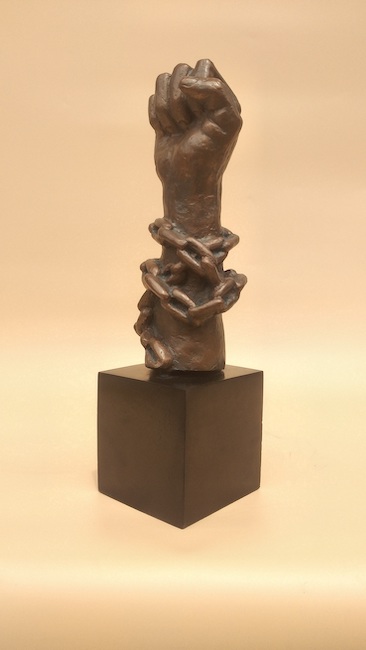
La scultura Black Tuesday (Martedì nero) è stata eseguita in memoria del 20 ottobre 2020 quando manifestanti pacifici che chiedevano lo scioglimento della Squadra Speciale Anti Rapine di Lagos a seguito delle violenze spesso concluse con omicidi perpetrate dal corpo di polizia mai punito, furono barbaramente uccisi; il pugno chiuso rappresenta la voce delle persone stanche dei soprusi e desiderose che la giustizia sia applicata anche a chi, pur dovendo proteggere il popolo in realtà si macchia di peccati ben peggiori, la catena è invece l’auspicio che i responsabili delle violenze e degli omicidi siano imprigionati e condannati.
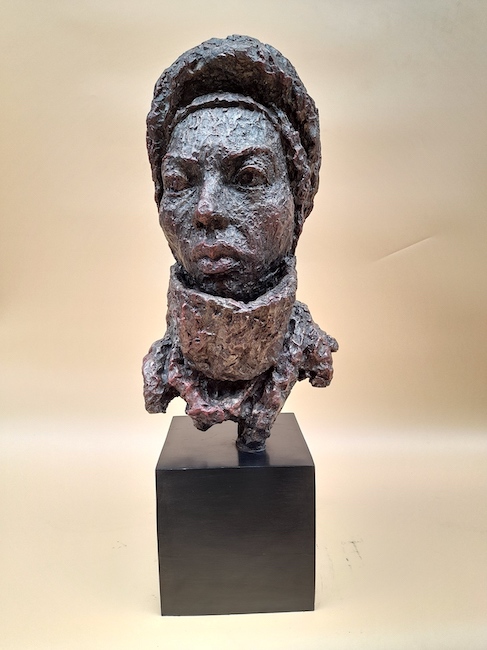
A differenza delle altre sculture, tutte finemente levigate, l’opera Explorer (Esploratore) resta invece grezza, quasi come se Luke Osaro volesse evidenziare le infinite esperienze, gli sterminati panorami, reali o metaforici, che si aprono davanti allo sguardo di chi desidera uscire dai confini e avventurarsi verso il non conosciuto, verso tutto ciò che costituisce un mondo da scoprire, una conoscenza da conquistare, un’avventura da vivere e che lascia tracce indelebili nell’interiorità del protagonista, solchi nella memoria che vanno a comporre il puzzle di una personalità in grado di essere la somma di quel vissuto e proprio in virtù di questo necessitante di essere descritta in maniera sfaccettata. Il respiro dell’Africa è fortemente presente nelle sculture dell’artista che narra in maniera armonica e al tempo stesso poetica, tutto l’amore per la sua terra, tutto il desiderio di farla conoscere e scoprire al mondo.
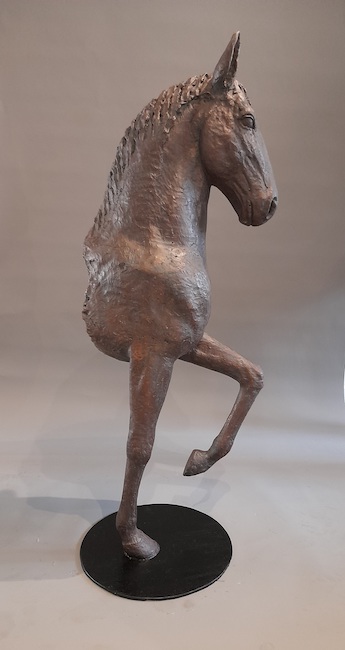
Luke Osaro inizia la sua carriera artistica nel 2004 e da quel momento in avanti partecipa a molte mostre collettive e personali, ricevendo premi e riconoscimenti per il suo innegabile talento che lo colloca tra gli artisti emergenti di maggiore spicco della Nigeria; è membro della Società degli artisti Nigeriani e del gruppo Artzero.
LUKE OSARO-CONTATTI
Email: osaro0006@gmail.com
Facebook: https://www.facebook.com/luke.osaro
Instagram: https://www.instagram.com/osaro006/
Twitter: @osaro006
The voice of Africa between tradition and contemporaneity in Luke Osaro’s sculptures
In contemporary art we often see a total stylistic innovation, an overcoming of everything that had distinguished previous languages in order to elaborate and generate something distant and detached from the rules and schemes of the past. In this process of regeneration, some artists tend almost to forget their artistic and narrative origins, almost as if the point of view must necessarily lean towards contemplation and understanding of the present. However, there are others who cannot help but remember the traditions of their land and mix them with current techniques, thus creating a recognisable, original and fascinating style.
From the early years of the 20th century, the African continent began to exert a strong attraction on European artists who were encouraged by the unprecedented ease of travel, thanks to the creation of faster ships than in the previous century, to go and study those tribal masks, those traditional and stylised images that became the basis for the sculptures and paintings of some of the greatest exponents of the art of that period; this new interest went down in history as Primitivism. Pablo Picasso drew inspiration from the images of local carvers and sculptors to design the faces of his multi-faceted, disjointed works, depicting different points of view and cancelling depth and perspective, just as Amedeo Modigliani drew inspiration from traditional African wooden sculptures to graphically elaborate his women with long necks, both in his paintings and in his few sculptures; Henri Matisse, a member of the Fauves and later of Expressionism, understood the expressive power of the simplicity of tribal masks and drew inspiration from them for his compelling paintings. Once the period of colonialism had passed and the path of interpenetration between the different cultures, African and European, had begun to emerge on the continent below the Mediterranean Sea, several art schools began to take shape through which students could study the traditions of the past and at the same time study the classical techniques developed by the great international masters, whose stylistic signature they could deepen and personalise, allowing their talent to emerge freely, less conditioned by European academies and decidedly more linked to the traditions of their countries of origin.
It was precisely between the 1950s and the 1980s that the world of art world began to pay attention to the new generation of African artists, organising group exhibitions all over the world to allow their creative production to be known internationally. Among the leading names of this new generation of artists, we cannot fail to mention the Egyptian Fati Hassan, the first African artist to participate in a Venice Biennial in 1988, whose paintings and installations mix strong symbolism with letters of the Arabic alphabet that thus become works of art, and the Informal Materialism of Ghanaian El Anatsui, who uses clay, wood and traditional fabrics of his land to create large tapestries in which the charm of solemn Nyekor ceremonies is combined with that of Kente fabrics. Nigerian artist Luke Osaro fits into this contemporary creative panorama through sculpture, in which he maintains a strong bond with his homeland, representing queens, ordinary women, wise elders and pride in belonging to his people, with a strong symbolic capacity capable of imbuing his characters with an aura of referential respect, as if allowing himself to be observed constituted a gift of trust to the artist who was immortalising them, certain that he would interpret them in the right way, in their spontaneous nature. Graduate in Fine Arts from the prestigious University of Obafemi Awolowo, in the Ile-Ife of Osun State in Nigeria, Osaro has had the opportunity to experiment and blend his creative inspiration, the traditions of his country and the classical execution approach to create fascinating artworks, silent but strongly expressive, in which the magic of the continent to which the artist belongs emerges and envelops the observer with its ability to speak directly, simply and at the same time revealing all that belongs to its people, the pride, solemnity and royalty that transpire from the poses, looks and hairstyles that the artist recounts.
The materials used are bronze and bonded stone, in virtue of which Osaro gives vent to his mastery in shaping to highlight expressions, details, indispensable particulars of the subjects he decides to tell and describe in their complexity. In the sculpture Scent of Eden, the artist depicts a young tribeswoman covered by a veil of essential material so as not to be completely visible to the outside world, but at the same time eager to be noticed, almost as if waiting for an event to occur, an encounter for which she has adorned herself in accordance with tradition; her face betrays her trepidation, while her hairstyle reveals her expectation, that she has carefully prepared herself to receive a lover or an important circumstance towards which she tends. Bronze is harmoniously associated with the woman’s features, as if it were the most appropriate material to emphasise the fact that she belongs to a race that is finally asserting itself in a priority way in the rest of the world, after centuries of silence and subjugation, also through art, revealing, without the need to shout, the uses and customs, the expressive serenity of living in a way that is still very much linked to nature, to the simplicity of a slower rhythm than that of western civilisations. The artwork Hakimi, Nigerian name for a tribe ruler, tells of the great respect the African people have for their elders, who are in fact true sages because they hold the traditions that must be handed down to the new generations. The man’s face is solemn, inspiring respect precisely because of his deep, meditative gaze, but at the same time eager to pass on his knowledge, to be of solace and support to those in need, to instil confidence in anyone who does not have his experience and who relies on him to help them progress along their own path in life.
Solidarity and a sense of community are deeply rooted in African society and form the basis of existence, and it is this that emerges from Luke Osaro’s work, that awareness of the elderly person being useful to those around him until the last day of his life. The Black Tuesday sculpture was created in memory of 20 October 2020, when peaceful protesters calling for the disbandment of the Lagos Special Anti-Robbery Squad, following the violence that often ended in murder perpetrated by the unpunished police force, were barbarously killed; the clenched fist represents the voice of the people who are tired of the abuse of power and want justice to be applied to those who are supposed to protect the people but who are actually guilty of much worse sins, while the chain is the hope that those responsible for the violence and murders will be imprisoned and sentenced. Unlike the other sculptures, all of which are finely polished, Explorer remains raw, almost as if Luke Osaro wanted to highlight the infinite experiences, the endless panoramas, real or metaphorical, that open up before the gaze of those who wish to leave their boundaries and venture towards the unknown, towards all that constitutes a world to be discovered, a knowledge to be conquered, an adventure to be lived and that leaves indelible traces in the interiority of the protagonist, furrows in the memory that go to make up the puzzle of a personality capable of being the sum of that experience and precisely because of this needing to be described in a multifaceted way. The breath of Africa is strongly present in the artist’s sculptures, which narrate in a harmonious and at the same time poetic way, all the love for his land, all the desire to make it known and discovered by the world. Luke Osaro began his artistic career in 2004 and since then has taken part in many group and solo exhibitions, receiving awards and recognitions for his undeniable talent, which places him among the most outstanding emerging artists in Nigeria; he is a member of the Society of Nigerian Artists and the Artzero group.


